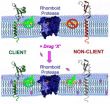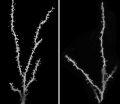(Press-News.org) Algae might seem easy to ignore, but they are the ultimate source of all organic matter that marine animals depend upon. Humans are increasingly dependent on algae, too, to suck up climate-warming carbon dioxide from the atmosphere and sink it to the bottom of the ocean. Now, by using a combination of satellite imagery and laboratory experiments, researchers have evidence showing that viruses infecting those algae are driving the life-and-death dynamics of the algae's blooms, even when all else stays essentially the same, and this has important implications for our climate.
According to results reported in the Cell Press journal Current Biology on August 21, a single North Atlantic algal bloom, about 30 kilometers in radius, converted 24,000 tons of carbon dioxide from the atmosphere into organic carbon via a process known as carbon fixation. Two-thirds of that carbon turned over within a week as that bloom grew at a very rapid rate and then quickly met its demise. A closer look at those algae revealed high levels of specific viruses infecting their cells.
To put it in perspective, Assaf Vardi of the Weizmann Institute of Science in Israel says that this patch of ocean fixes about as much carbon as an equivalent patch of rainforest and then almost immediately turns much of it over.
"This is, of course, only one patch out of numerous co-occurring patches in other parts of the Atlantic Ocean," adds Ilan Koren, also of the Weizmann Institute, not to mention those algal blooms that appear in other seasons and ecosystems. "While the impact that viruses have on the entire ecosystem was previously estimated to be very large, we provide the first approach to quantify their immense impact on open ocean blooms."
Important questions remain about the ultimate fate of all that carbon taken in by algal blooms, the researchers say. Much of it is probably recycled back to the atmosphere by bacteria. But it's also possible that the virus-infected algae release sticky sugars and lipids, leading their cells and the carbon within them to sink faster to the ocean floor.
"If the latter scenario is true, it will have a profound impact [on] the efficiency of carbon dioxide 'pumping' from the atmosphere to the deep ocean," Vardi says. "This carbon will then have a better chance [of being] buried in the ocean sediment."
The findings will improve models that predict the future of algal blooms and their impact on climate. They also serve as a reminder that sometimes it really is the little things that matter.
"These interactions begin when one virus infects one cell, but they end up causing the collapse of massive blooms that span thousands of kilometers," Koren says. "These life-and-death interactions on the micro scale have huge importance on the large scale and vice versa."
INFORMATION:
Current Biology, Lehahn et al.: "Decoupling physical from biological processes to assess the impact of viruses on a mesoscale algal bloom."
Viruses take down massive algal blooms, with big implications for climate
2014-08-21
ELSE PRESS RELEASES FROM THIS DATE:
Biologists reprogram skin cells to mimic rare disease
2014-08-21
Johns Hopkins stem cell biologists have found a way to reprogram a patient's skin cells into cells that mimic and display many biological features of a rare genetic disorder called familial dysautonomia. The process requires growing the skin cells in a bath of proteins and chemical additives while turning on a gene to produce neural crest cells, which give rise to several adult cell types. The researchers say their work substantially expedites the creation of neural crest cells from any patient with a neural crest-related disorder, a tool that lets physicians and scientists ...
Sequence of rare kidney cancer reveals unique alterations involving telomerase
2014-08-21
HOUSTON – (Aug. 21, 2014) – An international scientific collaboration led by Baylor College of Medicine has revealed clues about genetic alterations that may contribute to a rare form of kidney cancer, providing new insights not only into this rare cancer but other types as well.
The collaboration, a project of the National Institutes of Health's Cancer Genome Atlas initiative, completed the sequence of chromophobe renal cell carcinoma and published the results today in the journal Cancer Cell.
"The Cancer Genome Atlas is a federally funded national effort that has ...
Some anti-inflammatory drugs affect more than their targets
2014-08-21
Researchers have discovered that three commonly used nonsteroidal anti-inflammatory drugs, or NSAIDs, alter the activity of enzymes within cell membranes. Their finding suggests that, if taken at higher-than-approved doses and/or for long periods of time, these prescription-level NSAIDs and other drugs that affect the membrane may produce wide-ranging and unwanted side effects.
More positively, the researchers say, their work provides the basis for a test that drug developers can use to predict and perhaps avoid these side effects in new medicines they make. A summary ...
Children with autism have extra synapses in brain
2014-08-21
NEW YORK, NY (August 21, 2014) — Children and adolescents with autism have a surplus of synapses in the brain, and this excess is due to a slowdown in a normal brain "pruning" process during development, according to a study by neuroscientists at Columbia University Medical Center (CUMC). Because synapses are the points where neurons connect and communicate with each other, the excessive synapses may have profound effects on how the brain functions. The study was published in the August 21 online issue of the journal Neuron.
A drug that restores normal synaptic pruning ...
Research explains how cellular guardians of the intestine develop
2014-08-21
Even the most careful chosen meal can contain surprises. To defend against infectious microbes, viruses or other potential hazards that find their way to the intestines, a dedicated contingent of immune cells keeps watch within the thin layer of tissue that divides the contents of the gut from the body itself.
New research at Rockefeller University sheds light on the development of a unique class of immune cells known as intraepithelial lymphocytes (IELs) that reside in this critical interface. The findings, published August 21 in Immunity, may help lead to new insights ...
Alternate mechanism of species formation picks up support, thanks to a South American ant
2014-08-21
A newly-discovered species of ant supports a controversial theory of species formation. The ant, only found in a single patch of eucalyptus trees on the São Paulo State University campus in Brazil, branched off from its original species while living in the same colony, something thought rare in current models of evolutionary development.
“Most new species come about in geographic isolation,” said Christian Rabeling, assistant professor of biology at the University of Rochester. “We now have evidence that speciation can take place within a single colony.”
The findings ...
Mouse model for epilepsy, Alzheimer's gives window into the working brain
2014-08-21
(SALT LAKE CITY)—University of Utah scientists have developed a genetically engineered line of mice that is expected to open the door to new research on epilepsy, Alzheimer's and other diseases.
The mice carry a protein marker, which changes in degree of fluorescence in response to different calcium levels. This will allow many cell types, including cells called astrocytes and microglia, to be studied in a new way.
"This is opening up the possibility to decipher how the brain works," said Petr Tvrdik, Ph.D., a research fellow in human genetics and a senior author ...
Hacking Gmail with 92 percent success
2014-08-21
RIVERSIDE, Calif. — A team of researchers, including an assistant professor at the University of California, Riverside Bourns College of Engineering, have identified a weakness believed to exist in Android, Windows and iOS mobile operating systems that could be used to obtain personal information from unsuspecting users. They demonstrated the hack in an Android phone.
The researchers tested the method and found it was successful between 82 percent and 92 percent of the time on six of the seven popular apps they tested. Among the apps they easily hacked were Gmail, CHASE ...
Researchers identify potential risk factors for urinary tract infections in young girls
2014-08-21
Winston-Salem, N.C. – August, 21, 2014 – Young girls with an intense, red, itchy rash on their outer genital organs may be at increased risk of developing urinary tract infections (UTIs), according to new research from Wake Forest Baptist Medical Center. The treatment may be as simple as better hygiene and avoiding potential irritants such as bubble baths and swimming pools.
"Vulvitis is a common condition affecting women and girls of all ages," said senior author Steve J. Hodges, M.D., associate professor of urology at Wake Forest Baptist. "We found that girls with ...
Difficulty assessing effort drives motivation deficits in schizophrenia, study finds
2014-08-21
SAN FRANCISCO, Aug. 21, 2014 – Individuals with schizophrenia often have trouble engaging in daily tasks or setting goals for themselves, and a new study from San Francisco State University suggests the reason might be their difficulty in assessing the amount of effort required to complete tasks.
The research, detailed in an article published this week in the Journal of Abnormal Psychology, can assist health professionals in countering motivation deficits among patients with schizophrenia and help those patients function normally by breaking up larger, complex tasks into ...






